In an open gazebo
If the building is open, the materials from which its ceiling will be made must be high-strength and wear-resistant. They should not be afraid of wind, rain, heat. When installing, take into account the service life of the materials so as not to be unpleasantly surprised after five to seven years that the ceiling has subsided or lost color.

In open gazebos, it is undesirable to use fabric, because rain or heat will turn a beautiful canvas into a piece of rag in a few weeks. Subsequently, a complete dismantling and replacement of the web will be required. If there is no desire and time to tinker with the lining of the inner coating, then it is better to order a waterproof drywall.
The sheet thickness should be no more than 22 mm. But you shouldn't place high hopes on the durability of this material. It will last a maximum of 2 years. Suitable as a temporary cover.
Here you can read about which polycarbonate is better to choose for covering the gazebo.
You can decorate the ceiling with natural wood. It looks natural and aesthetically pleasing, accepts tint and soil well. The most important thing is to soak the boards well with an antiseptic before installation, which will prevent mold and rotting processes. Fans of practicality should choose those coatings that are easy to care for and process. These include: lining, PVC module, polycarbonate honeycomb or monolith.

In a closed gazebo
In a closed gazebo, you can allow yourself everything. Stretch ceiling, beam ceiling in the design solution of a loft with chiffon suspensions (just do not forget that every season you will have to remove it and put it in order so that it looks decent), ceiling modular glass, foam plastic, foam plates and any other design options you can apply for finishing gazebos of a closed type.

A variety of finishing materials allows you to choose any option for decorating the gazebo ceiling. The main thing is to think over the design style, buy high-quality materials and take a responsible approach to their installation.
Options for finishing the walls of the gazebo
Before finishing the garden house, you should choose the right building materials.
Wood paneling
Since most garden houses are constructed of wood, the most suitable way to decorate them is to decorate the gazebos with wood. Natural wood is a high-tech building and finishing material with excellent decorative properties.
The easiest way to finish the gazebo with your own hands is to cover the structure with wooden slats. They are used to decorate the walls of a building and provide additional protection, shade.
Tip: the lattice fence can be decorated with climbing plants that will beautifully braid the house, create coolness and comfort.
An example of how to sheathe a gazebo with slats
One of the options for wood finishing is the use of edged boards. For covering the structure, boards of the required length are used, which are mounted on a metal or wooden frame. Edged boards can be used for finishing the side walls and also the ceiling.
Attention: to protect the tree from negative weather conditions and pests, it is treated with fire retardants and antiseptics.
Beautiful wooden decoration of arbors, photo
Using lining for cladding garden houses
Sheathing of the gazebo of a closed type can be made with wooden clapboard. Thanks to the double-sided groove-ridge connection, the calibrated boards fit tightly to each other.The lining has the following advantages:
- good heat and sound insulation properties;
- presentable appearance;
- ease of installation;
- the ability to use for finishing structures both inside and outside;
- affordable cost.
The lining is made of different types of wood - alder, linden, oak, larch, aspen, cedar, but pine is the best option in terms of quality and price. Sheathing with this sawn timber will add warmth and comfort to the structure, because natural wood creates a pleasant indoor climate.
wooden lining has many shades, it can also be tinted using special tools.
Wooden lining is an example of how to sheathe a gazebo outside, photo
A calibrated wooden plank can be mounted in a variety of ways. Horizontal lining with clapboard will create the illusion of expanding the space, and the vertical arrangement of the boards will make the low house visually higher. It looks interesting clapboard wall clapboard diagonally, as well as in a combined way.
Please note: before you start decorating the garden house with clapboard, you should lay the wiring and connect the lighting.
Options for lining the gazebo with clapboard
Decorating garden houses with siding
No less popular material for cladding buildings is siding - plastic lining. It is resistant to moisture and temperature fluctuations, is easy to clean, has a variety of colors and textures, and can be used for interior and exterior cladding of buildings.
Attention: along with siding lamellas, you should also purchase accessories - corners, connecting elements.
Photo of gazebos from siding in personal plots
Stone
You can give the exterior and interior of the garden building a modern look by finishing the gazebo with stone. The use of this material is a guarantee of reliability and durability. For cladding a garden house, you can use sandstone, flagstone, decorative artificial stone, as well as granite and marble.
Stone finishing gives the building a monumentality
Sheathing of gazebos with cellular polycarbonate
Decorating a garden house quickly, cheaply and beautifully allows the use of polycarbonate. This material is light and airy, transmits sunlight into the room, is quick and easy to install, has many colors and low cost.
polycarbonate sheathing deforms from strong loads, therefore, when installing sheets, elastic thermal washers are used.
Simple garden pavilions lined with polycarbonate
Types of flooring for gazebos
For finishing the floor in garden houses, you can use decking and floorboards, paving slabs and concrete fill. An artificial stone is also used, but we will not mention it in this section, since the properties of the material have already been described above.
Decking and floorboard cladding
Decking is made from wood-polymer composite, the percentage of wood in which, depending on the brand, can be from 30% to 80%. WPC will cost more than a floorboard, but the difference in price is fully covered by the following material qualities:
- Resistant to chemical and mechanical damage.
- Ability to withstand a wide range of temperatures, from -50 to +75 degrees.
- The sheathing is not affected by fungi, insects and rot.
- It has a long service life without requiring special maintenance.
- Has a high fire resistance.
- The casing retains its excellent appearance for the entire service life.
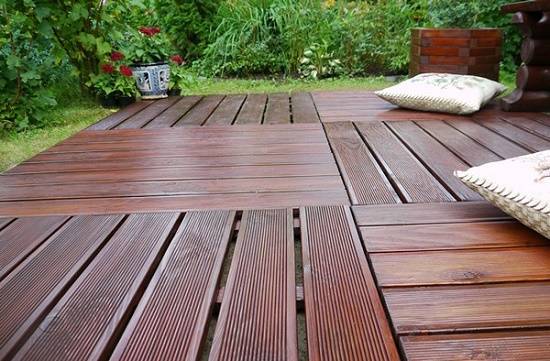
The floor in the gazebo: finishing with a decking board
A floorboard for a gazebo will cost less than a terrace floorboard, and therefore it is very often used for cladding. Wood lends itself well to processing and does not require special fittings during installation. In addition, such cladding has high aesthetic qualities.
Please note: wood is susceptible to mold and rot. The floor in the gazebo, trimmed with wood, must be treated with antiseptics once or twice a year. ... How to finish the floor in a garden house: sheathing from natural boards
How to finish the floor in a garden house: sheathing from natural boards
Paving slabs and concrete for finishing
Paving slabs are well suited for gazebos in which sources of open fire are supposed to be placed. For laying the tiles, you do not need serious site preparation, you just need to level the ground and make a sand cushion. The material itself is fireproof, abrasion and chemical resistant. With proper installation, paving slabs can last a very long time without losing their appearance.
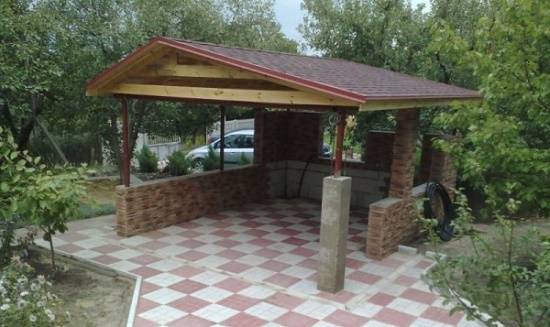
How to make a floor cladding: laying paving slabs
The concrete floor is also suitable for gazebos with barbecues, barbecues or grills. It is as durable, fireproof and resistant to various influences as paving slabs. But the preparation of the base for the concrete floor will already be serious. In addition to leveling the site, you will have to create floor formwork and reinforcing mesh here.

DIY gazebo decoration: concrete floor
Flooring
A top coat of paint or varnish will provide additional protection against abrasion and give the floor a finished look. This option is used with a closed type of structure. For open ones, it is better to take a terrace board or porcelain stoneware, they will be discussed further.
Porcelain stoneware
To lay it, you will need a perfectly flat concrete screed; work is carried out only in the warm season. The material is durable and wear-resistant, it contains granite chips, laying is carried out according to the principle of ceramic tiles. The work is laborious, but the material itself is inexpensive. When choosing porcelain stoneware for your summer cottage, opt for a matte surface, a smooth floor on the street is undesirable.
A good option that allows you to combine garden paths with a gazebo area into one system. The work involves leveling and tamping a sand cushion, on which the improvement elements are laid. And also tapping with a rubber mallet in order to compact the planting of the paving stones into the prepared base with building sand, which can eventually be refilled with the subsidence of the seams.
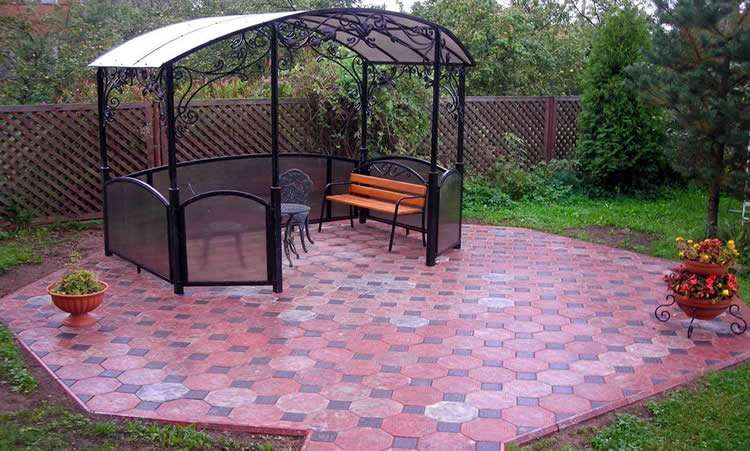
A platform in the country lined with paving slabs
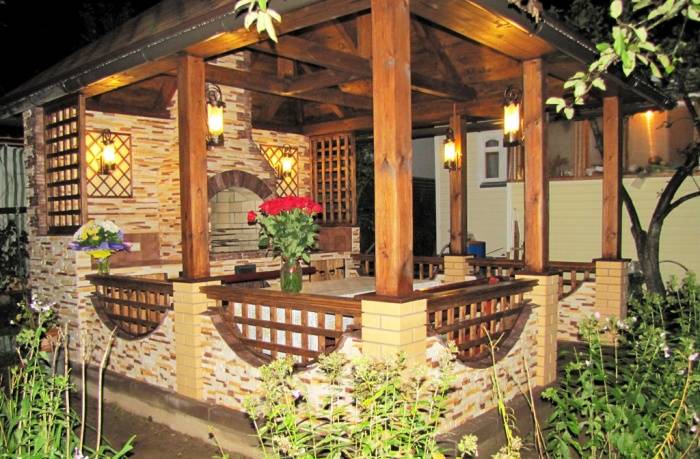
Stylish and durable material, suitable for both open spaces and closed gazebo roofs. The texture of wood, pleasant colors and a durable, wear-resistant polymer distinguish this material from others, although the cost is higher than ordinary wooden boards.
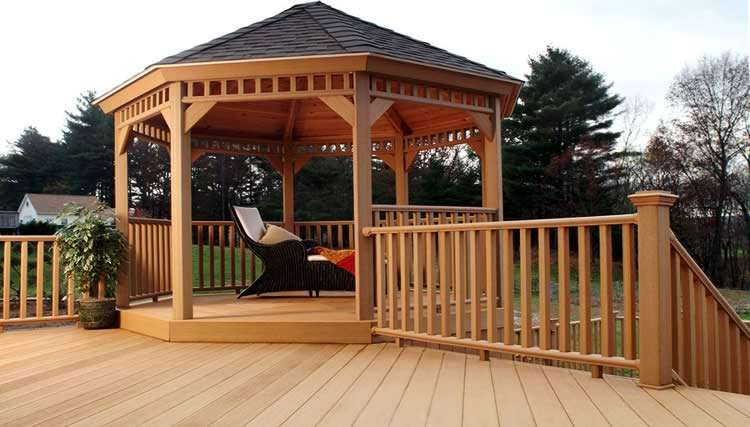
The platform and the floor are made of decking
Some designers suggest covering the floor with different materials, if the gazebo is roomy and visually requires the separation of functional areas: for outdoor games and dancing, for eating, for kitchen utensils and a barbecue - it is not necessary to use one flooring option.
How to sew the ceiling
For finishing the ceiling, a translucent version is used using a lath, applying it at a certain distance, or dense clapboard sheathing. If you leave the ceiling unseated, a more utilitarian look will be created, the rafters will be visible, but the under-roof space will increase the height of the gazebo.
Cheap and cheerful - this is how the polycarbonate finish looks. Ideal for the canopy of a spacious gazebo on a metal frame, it has many colors with varying degrees of transparency. The lightness and cellular structure of the material requires careful installation and operation.

The roof is made of cellular polycarbonate
The building materials market is constantly evolving, more affordable and interesting types of finishes appear.Original results can be achieved by the unity of the chosen style in the design of garden paths, a porch of a house and a veranda or a gazebo, applying your own sense of harmony and taste.
Popular materials for interior cladding
The interior decoration of the gazebo is made of the same materials, but taking into account the purpose of the gazebo. To make the design stylish and harmonious, the following types of materials are chosen for the interior wall and ceiling cladding:
Wood. The walls inside the gazebo will not get wet from the rain, so they can be decorated not with plastic, but with natural wood panels, pine clapboard (a budget option) or a board. Wooden walls can be given any color by varnishing, waxing, acrylic paint, or simply staining.
On the choice of material for the floor of the gazebo in the following video:
-
Plywood... This material has worked well; it is able to last longer than a board or lining. On sale is decorative (laminated) plywood, faced with a film coating with decorative paper and varying degrees of water resistance. Plywood sheets with high water resistance, UV and moisture resistant, can also be used for external cladding. The disadvantage of plywood lies in the technology of its production. To increase the strength, the layers are glued with various types of adhesives, many of which are harmful to health. In civil engineering, it is recommended to use materials marked with FC (based on the least hazardous carbamide glue).
-
Brick, tile, stone... Versatile material, practical, durable and beautiful. Such wall and parapet cladding is especially relevant in gazebos equipped with a barbecue, fireplace or barbecue - where the rules prohibit the use of wood or plastic. Facing bricks are often used to decorate the oven and the kitchen area, it turns out stylishly and safely.

The use of wood in the interior decoration of the gazebo
Vinyl siding. In interior decoration, it is not used as often as in exterior. PVC siding does not have the advantages of natural materials, but it is easier to care for and does not change properties when exposed to smoke. Often, siding is used to sheathe the ceiling in the gazebo.
About a pine gazebo with a decking board in the following video:
Tile
Paving slabs and ceramic floor tiles can be valuable precisely as a facing material for gazebos flooring. The tiled floor is, along with brick and stone, one of the most durable and practical. As a rule, during the reconstruction of old brick and stone arbors, which have lost their proper aesthetic appearance, their columns and walls, as an option, can be decorated or decorated with ceramic tiles.
Materials for wall decoration
Most often, garden houses are finished with wood: clapboard, block house and rail. The second most popular material is polycarbonate; artificial stone is used a little less often. Siding is the least commonly used cladding.
Decorating gazebos with wood
Sheathing the gazebo with clapboard is not in vain the most popular type of decoration. This material has several advantages:
- The finish is suitable for both external and internal cladding.
- Easy to install.
- Can be relatively inexpensive depending on the type of wood.
- Possesses high decorative qualities.
- Environmentally friendly.
- In a closed gazebo, such a sheathing contributes to good heat and sound insulation.
Both the lining and the block house described below are suitable for both external decoration and decoration inside the gazebo. The disadvantages of this finish are standard for natural wood: fire hazard and low biostability.
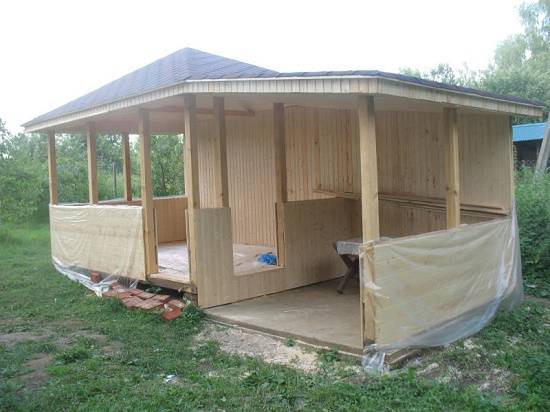
How to hem the ceiling in the gazebo, as well as the walls, outside and inside: lining
The block house is very similar in technical parameters to the clapboard, here even the elements are fastened to each other in the same way. The only difference is the outer side of the board - it imitates a log. Therefore, decorating gazebos with a block house is very often used to decorate buildings in the Russian style.
Please note: the more resistant the wood species to atmospheric manifestations, the more expensive the lining and block house from it. However, in the selection of material for covering the gazebo there is always an opportunity to find a price-quality ratio that suits you.
For example, instead of expensive oak for decoration, you can take pine, which is almost as resistant to moisture, but has less impact resistance.
How to sheathe the gazebo outside: photo of finishing with a block house
Wooden slats and lattices from them are used to decorate open gazebos and "living", green garden houses. In both cases, there will be no division into inner and outer skin for obvious reasons. The cost of such finishing will depend on the type of wood in the same way as in the case of the clapboard and block house. In the photo below, there is an elementary lining of the gazebo with separate slats, but if you wish, you can assemble beautiful lattices with different patterns from this lumber.

How to sheathe a gazebo with slats: it can be separately attached strips or pre-assembled lattices
Decorating the gazebo with stone, polycarbonate and siding
Welded and forged arbors are most often finished with polycarbonate, less often - wooden. This material is plastic, can withstand high impact and rupture loads, and weighs relatively little. In addition, polycarbonate is absolutely not afraid of moisture and cannot be affected by mold or rot. The material is produced transparent and translucent, in different colors. Sheathing is mounted very easily, you just need to purchase special thermal washers.
Please note: if your garden house has curved walls, then it is better to take the material for decoration thin, up to 16 mm in thickness, or completely single-layer. Thick cellular polycarbonate will be difficult to bend to the shape of the walls. ... Decorating gazebos: photo of polycarbonate sheathing
Decorating gazebos: photo of polycarbonate sheathing
Artificial stone is suitable for covering arbors from bricks, as well as from metal and wooden frames, sheathed with DSP sheets. The material will cost more than any type of wood finish, but it also has its advantages:
- Simplicity and ease of installation finishing.
- A wealth of colors and textures.
- The durability of the finished sheathing.
- Fire safety.
Artificial stone is very good to use for finishing gazebos with a stove complex, both for the outside and for their inside.
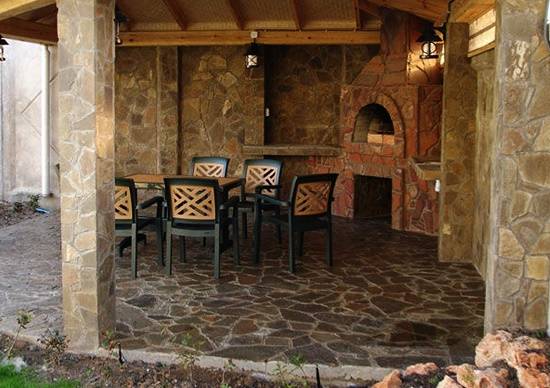
Photo of finishing the gazebo inside: artificial stone
Siding, as mentioned above, is used for cladding garden houses quite rarely and most often for closed buildings, as an external decoration. The photo of the gazebo from the siding below is a typical version of this design.
Here are the main benefits of siding:
- Resistant to moisture, mold, rot and all kinds of chemicals.
- Does not react to atmospheric changes.
- The cladding is quick and easy to assemble, there is always the necessary fittings on sale.
- Fire resistance finish. This applies to the cladding of the gazebo with metal siding. Plastic should be protected from fire.
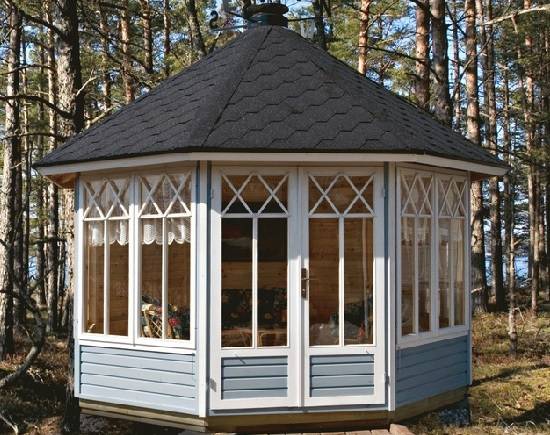
How to sheathe a gazebo in the country: siding
Processing technology
Since varnish, paint, water glass and stain (protection against pests) are used as impregnating compounds, the system for applying different types of preparation may differ slightly.
Read also: All about pests.
The jar with the composition is opened, then mixed thoroughly. It is necessary to apply the substance quickly, evenly covering the entire surface, without leaving empty areas, otherwise the mixture will be absorbed unevenly. After applying one layer, we give time to dry (about two hours). Carefully remove the villi, if any. After drying, you need to cover the tree with the composition a second time, and then a third time.
Here are the features of applying different mixtures:
- The varnish is selected to be weather-resistant for the treatment of outdoor surfaces.The processing principle is the same as for paint. Alas, in the heat, the varnish cracks, crumbles, so you will often have to process the gazebo with it if you want to keep the wooden elements in good condition for a longer time.
- The paint prolongs the life of the material for a long time, but changes its color. In the sun and in the cold, the composition changes properties, gradually collapsing. The color will have to be renewed every year, removing the old layers with a spatula, and again cleaning the surfaces. Apply the paint with a hair or metal brush. If the surface has darkened over the years, it is recommended to treat it with a special bleach for wood-based materials.
- The stain is applied with a roller, not so much painting, but evenly pouring over the wooden boards.
- Liquid glass is used as an insecticide. Experts say that it is better to rip off the existing bark from new boards in general, then the bark beetle will not be scary.
Wooden buildings do an excellent job with this task, but they require you to pay enough attention to them periodically. Choose high-quality paints or varnishes, and then your creation will serve for a very long time.
Materials for external walls
The question of how to sheathe the gazebo outside is very important. The materials must correspond to the general concept of the gazebo, be durable and resistant to the effects of the external environment. In this case, the frame of the structure can be made of wood or metal.
It does not matter. Wooden elements can be perfectly mounted on a metal frame, creating a gazebo in a traditional style
Several basic materials for finishing external walls should be highlighted:
Siding. This is the most convenient and affordable option. Such material is suitable for all types of gazebos - with barbecue, two-story, heated, and so on;
Wooden beams, including glued ones. It is a very aesthetic and functional material. It does not have a lot of weight and is great for gazebos on a pile-screw or columnar foundation;
If the building is made of bricks or blocks, clinker bricks or natural stone can be used for decoration.

Siding
This material is the most popular. This is due to the unique combination of its consumer properties and low cost. The main features of the specified material for finishing the gazebo should be additionally highlighted:
There is a wide range of colors on the market. Therefore, the facade of the gazebo can be made in beige, white, blue, yellow or any other color. A combination of several colors is possible, which will allow you to create a structure according to the owner's taste;
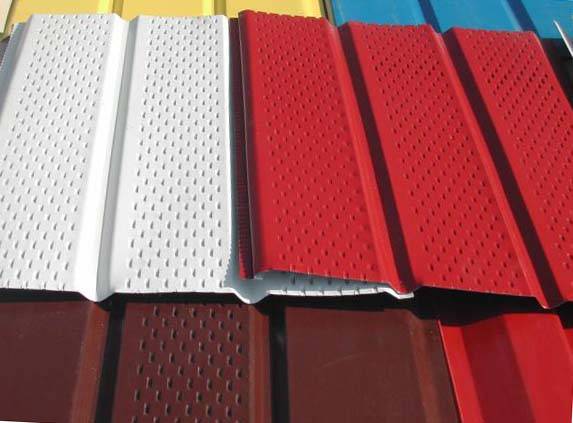
Siding can be easily installed on any surface. It can be a brick base or a wooden base. Ease of installation makes it possible to carry out work at high speed. In addition, it is also available to make the facing of the gazebo on your own;
The material retains its appearance and functional qualities for several decades. Subject to the purchase of high-quality siding, you can be sure that the structure does not lose color saturation, does not deform during the period of use;
The material is non-flammable and completely fireproof;
If individual fragments of the facade are damaged, the siding can be easily dismantled and the damaged part can be quickly replaced.
Wood
It is the material that creates the traditional look of the gazebo. The tree is environmentally friendly and has a beautiful natural texture. For finishing the facade, it is best to sheathe the gazebo with panels or larch timber. Aspen is perfect. These types of wood practically do not lose their natural color. They will only darken slightly over time.

At the same time, wood is convenient in processing and installation. This allows it to be used even for gazebos with complex architectural shapes.
Clinker brick, facing stone
Such materials require a solid surface. Therefore, they are mounted on a base of masonry bricks or cement blocks. They are more expensive. At the same time, the gazebo made of these materials will last for decades, and its appearance will remain unchanged - without efflorescence or traces of wind erosion.
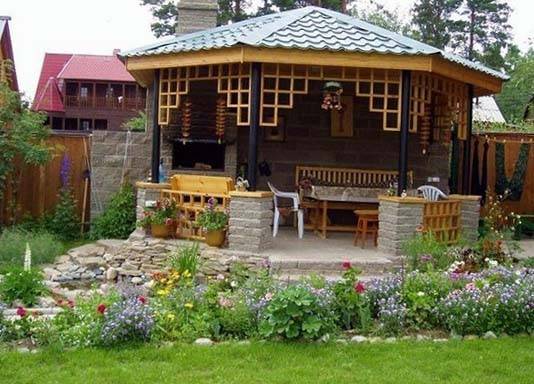
Wooden lining
In principle, you can sheathe a terrace or a gazebo with very different materials. So, in minimalist styles, polycarbonate is often used, and in eco styles, living greens are preferred to everything, beautifully wrapping around the columns of the rotunda. Wooden cladding is one of the most common, as it is very easy to manufacture and fits perfectly into the landscape. The lining gazebo in the photo is located in the garden.

In addition, wooden finishing lamellas have other advantages:
- extreme ease of processing - they can be cut, adjusted to size and laid in patterns, and not just vertically or horizontally;
- lining the gazebo with clapboard is an example of a very quick and easy do-it-yourself installation, since the elements here are fastened to each other using the thorn-in-groove method;

- the wood of the product is treated with special antiseptic compounds and tolerates temperature extremes, rain and snow extremely well;
- the lining needs minimal maintenance: it is enough to open it with varnish or paint the building;
- the material weighs little, has standard sizes that are very convenient for work;

the cost of sheathing is more than affordable and at the same time varied, since lamellas from different types of wood differ noticeably in appearance.
But the use of PVC lamellas should be avoided: although the material is resistant to water, it heats up much more in the sun. In addition, PVC lamellas do not tolerate the open sun well and quickly lose their color.
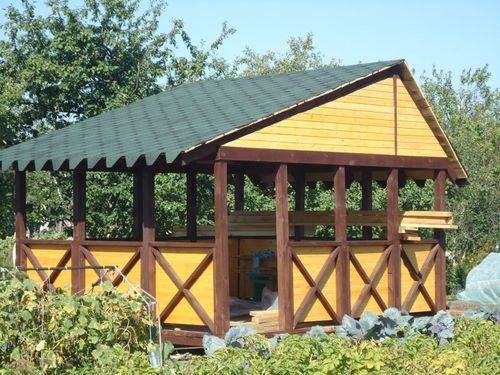
How to sheathe a gazebo with clapboard
Plating technology is extremely simple to do it yourself. Sheathed with material most often you need a fence, sometimes a ceiling - wooden finishing boards are not suitable for a roof, as, of course, for a canopy. For fastening, you need to use screws or nails, preferably galvanized.

- The material is attached to the crate. The latter is arranged from a bar fixed on vertical posts. The distance between the slats should be about 50 cm.
- The lining is fixed on nails or self-tapping screws, which are installed in the crest of the product.
- The material is fixed perpendicular to the crate, which must be taken into account when laying. If a more complex pattern is assumed, then the crate will need to be made more frequent and with crossbars. The photo shows an example of how to sheathe a crate with a pattern.
- Laying starts from the corner. The verticality or horizontalness of the lamellas is checked using a level.
- It is recommended to open the fence with varnish, at least 2 layers after the end of the work.
- The ceiling in the gazebo from the lining is arranged in about the same way. The crate is laid, the boards are cut to the appropriate length, taking into account the shape of the ceiling, and then fixed - as a rule, from the entrance, onto self-tapping screws. The finished ceiling must be varnished.
- Finishing the floor with material is undesirable, since it requires boards with a thickness of 20 mm. But it is quite possible to additionally decorate the walls with finishing, for example, by combining lamellas with a wooden lattice vertically or even diagonally, and not in the usual way - a conditional window and filling the fence.
